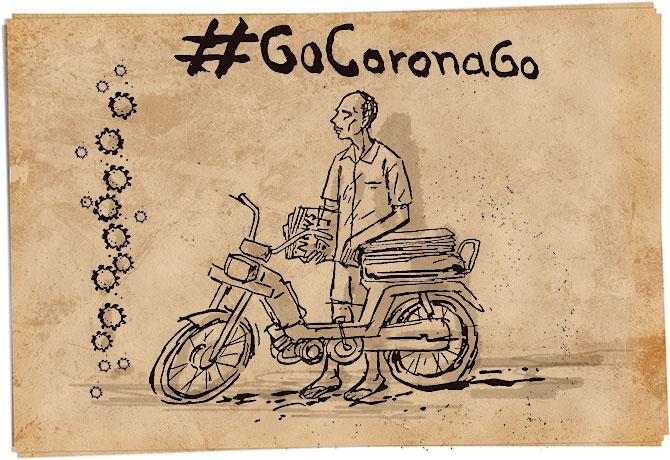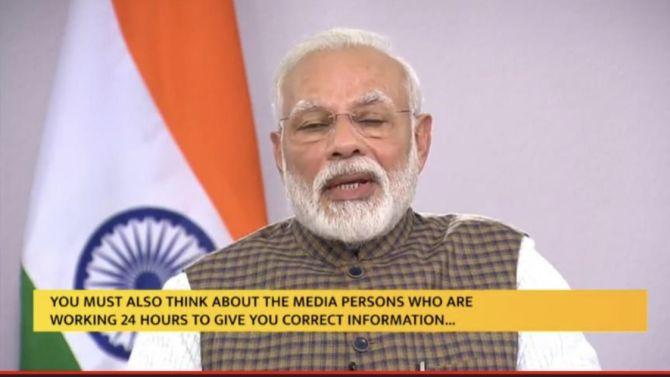'India's print media appears to be on the ventilator, gasping for breath, cutting staff, cutting salaries, cutting editions, cutting off its hands and legs,' notes Krishna Prasad.
Illustrations: Dominic Xavier/Rediff.com

In 1988, Andrew Grove, the founder and former CEO of the American chip-manufacturing giant Intel, published a book titled Only the Paranoid Survive, in which he floated the concept of the 'strategic inflection point'.
'A strategic inflection point is a time in the life of a business when its fundamentals are about to change. That change can mean an opportunity to rise to new heights. But it may just as likely signal the beginning of the end.'
Shorn of the jargon, a strategic inflection point is a 'nightmare moment'.
As a puny pathogen called #CoronaVirus brings the world to its knees, now is a good time to ask: Has the Indian print media sector reached a strategic inflection point?
Will it recover and rise once #COVID-19 has been conquered?
Or, will it sink further into irrelevance?
***
The signs are far from encouraging.
The Indian Newspaper Society (INS) has said the industry, hit by the 'triple whammy'/ of #CoronaVirus, falling advertising revenues and customs duty on newsprint, is in very real danger of turning "sick" (external link).
Citing a fall in ad revenues and print orders, the Indian Express group has mooted a 10 to 30 per cent salary cut (external link) for staff earning over Rs 5 lakh per annum, and warned of 'more sacrifices' if things do not improve.
Business Standard has followed suit.
More newspaper groups are likely to follow.
Sportstar, the sports magazine from The Hindu group, has suspended publication of its print edition for the first time in nearly 43 years, owing to the problem of distribution during the period of the lockdown.
India Abroad, the ethnic Indian weekly published out of New York, has shut shop in its 50th anniversary.
# At least 15 employees of Sakal Times, the English newspaper published by the Marathi group Sakal owned by the powerful Sharad Pawar family, have reportedly been let go in a 'cost-cutting exercise' without adequate notice.
In short, even before #CoronaVirus enters the next stage, India's print media appears to be on the ventilator, gasping for breath, cutting staff, cutting salaries, cutting editions, cutting off its hands and legs.
"We are all in a deep mess," says a leading newspaper baron.
***

To be sure, Indian newspaper owners collectively do tend to exaggerate their fears.
For instance, when the Manmohan Singh government approved the Majithia wage board recommendations in 2011, INS said the move "would kill most newspapers (external link)". Nearly 10 years on, most are still very much around; many have grown in size.
To be sure, again, it is not as if things were hunky-dory before #CoronaVirus arrived.
# Print publications, which depend almost entirely on advertisements for sustenance to make up for their low cover price, have never fully recovered from the downturn of the global economy that began in 2007-08.
# The explosion of the internet and social media has seen readers desert print publications in droves and spend more time online, where Google and Facebook take away nearly 70 per cent of online advertising revenue (external link).
# The falling value of the rupee and the rising price of oil has seen foreign newsprint get more expensive, on top of which the Narendra Modi government imposed a 10% customs duty (which has since been reduced to 5%).
That said, something about the current crisis suggests that it is far from ordinary.
For the first time, #CoronaVirus has squeezed print media at both ends of the pipeline: advertising revenue (because of lack of advertising) and circulation revenue (because of the inability to distribute).
Both shortfalls have happened before but never together.
"The story of print media can now be put neatly into two boxes, pre-Coronavirus and post-Coronavirus," says a newspaper manager.
"The former was bad; the latter is going to be infinitely worse."
***

Just like there is no one, single, monolithic, homogenous media, there is, of course, no one, single monolithic homogenous 'print media'.
There are newspapers and newspapers in dozens of languages -- and magazines.
What applies to one might not to the other. There are exceptions to every rule.
But for the first time, newspapers and magazines across India have been united in the manner in which they have been affected by #CoronaVirus.
Despite a blitzkrieg of stories and advertisements certifying newspapers as safe from the virus, distributors and their unions have refused to lift copies.
Apartment blocks and residents welfare associations have disallowed newspaper hawkers from delivering copies to individual homes due to fear of contamination.
With all retail and online businesses shut, publishers have been forced to trim pages, cut print orders, and make do with slim editions stuffed with low-yield tender notices.
Publications which have a pay wall have had to lower it partly or in its entirety since it was not economically viable to print small print runs, or see readers go elsewhere.
Journalists have reported, edited, designed and scheduled by remote, and everyone down the food chain has been compelled to tweet or post links of stories on WhatsApp groups to evangelise the e-paper.
In other words, in a moment of crisis, newspapers and their employees have been forced to relook at the very fundamentals of their business, inside out.
The question is which of these could become the 'new normal' when the virus threat has passed?
***

The piquant situation became clear during the so-called 'interaction" hand-picked representatives of print media had with Prime Minister Narendra Damodardas Modi (external link) six hours before he went on air on March 25 to announce a 21-day 'lockdown'.
That a PM who has not held a single press conference in six years, or did not meet them before he announced #Demonetisation in 2016 or revoked Kashmir's special status in 2019, was seeking them out, told its own story.
That he was only meeting the owners -- not the editors -- told another.
At the 'interaction', Modi, who has loudly advertised his contempt for independent news media on several occasions, was reduced to giving certificates to it: "'Its pan-India reach gives it a key role... it has tremendous credibility.'
Astonishingly, or perhaps understandably, his mundane comments ended up becoming the tagline for a Hindustan Times campaign.
An earlier comment by Modi found its way into the INS petition to Finance Mnister Sitharaman seeking a two-year tax holiday.
***
Media owners and managers generally believe in striking when the iron is hot.
Using a 'nightmare moment' to trim the topline, to cut flab, to downsize, to rightsize, to 'degrow', to extract concessions from the government, etc, is par for the course.
They have done it before and it is not beyond them to do it again.
To that extent #CoronaVirus gives them the perfect cover to take decisions that would have been difficult in peace time.
"Salary cuts are reflective of bad times, but great organisations should be able to weather the challenge and not pass it on to employees, my view," says a newspaper industry executive.
The peculiar aspect of print media's current plight is that all its traditional advertisers -- automotive, online retailers, construction, education, hospitality -- are also all hit by the same #Coronavirus shutdown, and all their businesses are down.
If and when things get back to normal, will they look at print the same way when the cheaper option of digital advertising is before them?
Or, will government advertising continue to be the revenue earner, with all its attendant risks of compliance and subservience?
Equally, will print media promoters and publishers look at their legacy businesses in the same way when they have seen online readership soar during the lockdown, without the attendant costs of production or distribution?
And will readers look at their media vehicles the same way when they have got their news, views and juice fresher, and straight into their pockets, almost for free?
***
News of the Union home ministry including 'newspaper delivery chain' in the list of essential items permitted to function in the 21-day lockdown period was reported with much glee by newspapers which have a vested interest in the matter.
But the big question little #Corona has posed is this: Information may be essential to citizens at a 'strategic inflection point' like a pandemic, but does that mean the same thing as physical newspapers and physical magazines?
And for those working in them it poses several questions: Will my publication be the same after this?
Will my role and function be the same?
Will my cost to company be the same?
Will reader expectations be the same?
Usually the answers to a question mark in newspaper headlines is 'no'.
Ditto and likewise.
Krishna Prasad is former editor-in-chief, Outlook, and former member, Press Council of India.










